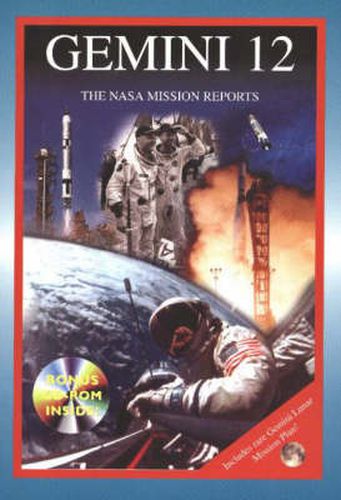Readings Newsletter
Become a Readings Member to make your shopping experience even easier.
Sign in or sign up for free!
You’re not far away from qualifying for FREE standard shipping within Australia
You’ve qualified for FREE standard shipping within Australia
The cart is loading…






NASA’s ambitious but essential Gemini Program was culminated in November 1966 with the launch of Gemini 12 from Kennedy Space enter’s Launch Complex 19. This tenth manned Gemini mission was the final opportunity to develop and practice many new techniques that were integral to the upcoming Apollo program. With the successful conclusion of the Gemini 12 mission, veteran astronaut Command Pilot James Lovell had set another new record with a total of 18 days in space, and Pilot Edwin (Buzz) Aldrin held the EVA duration record with an umbilical EVA at the Agena work station of 2 hours and 9 minutes. In all, three EVA (extra-vehicular activity) sessions were performed during the mission. Going into the Gemini 12 mission, many questions of EVA procedure were still unresolved. In the past, astronauts had expended too much energy simply staying in position. In an effort to better develop techniques and train astronauts, for the first time, underwater simulation was incorporated into EVA training. Using a submerged mock-up of the Gemini-Agena spacecraft, EVA training proceeded almost to the eve of launch. Training in the neutral-buoyancy underwater simulation allowed the astronauts to practice the entire EVA procedure in a single session – just as they would be required to do in space. This was a major advance over simulated weightlessness in aircraft parabolic flights, which provided only 30 seconds of weightlessness at a stretch. Gemini 12 successfully executed a fuelless station-keeping exercise for 4 hours and 20 minutes with the use of a dacron tether between the Gemini and Agena vehicles. Once the tether had been pulled taut, the reaction control systems for both vehicles were turned off, and the slight difference in the Earth’s gravitational effect on the two space vehicles was sufficient to keep the tether taut, so the two spacecraft remained at a constant separation, without the use of any reaction control fuel. Despite mission changes brought on by a radar lock-on failure and by a malfunction of the Agena Primary Propulsion System (PPS), the Gemini 12 mission was considered to be a major success, continuing the success story of the entire Gemini program. Apollo could take man to the Moon only after Gemini had introduced him to the space environment and taught him how to perform there. CD included.
$9.00 standard shipping within Australia
FREE standard shipping within Australia for orders over $100.00
Express & International shipping calculated at checkout
Stock availability can be subject to change without notice. We recommend calling the shop or contacting our online team to check availability of low stock items. Please see our Shopping Online page for more details.
NASA’s ambitious but essential Gemini Program was culminated in November 1966 with the launch of Gemini 12 from Kennedy Space enter’s Launch Complex 19. This tenth manned Gemini mission was the final opportunity to develop and practice many new techniques that were integral to the upcoming Apollo program. With the successful conclusion of the Gemini 12 mission, veteran astronaut Command Pilot James Lovell had set another new record with a total of 18 days in space, and Pilot Edwin (Buzz) Aldrin held the EVA duration record with an umbilical EVA at the Agena work station of 2 hours and 9 minutes. In all, three EVA (extra-vehicular activity) sessions were performed during the mission. Going into the Gemini 12 mission, many questions of EVA procedure were still unresolved. In the past, astronauts had expended too much energy simply staying in position. In an effort to better develop techniques and train astronauts, for the first time, underwater simulation was incorporated into EVA training. Using a submerged mock-up of the Gemini-Agena spacecraft, EVA training proceeded almost to the eve of launch. Training in the neutral-buoyancy underwater simulation allowed the astronauts to practice the entire EVA procedure in a single session – just as they would be required to do in space. This was a major advance over simulated weightlessness in aircraft parabolic flights, which provided only 30 seconds of weightlessness at a stretch. Gemini 12 successfully executed a fuelless station-keeping exercise for 4 hours and 20 minutes with the use of a dacron tether between the Gemini and Agena vehicles. Once the tether had been pulled taut, the reaction control systems for both vehicles were turned off, and the slight difference in the Earth’s gravitational effect on the two space vehicles was sufficient to keep the tether taut, so the two spacecraft remained at a constant separation, without the use of any reaction control fuel. Despite mission changes brought on by a radar lock-on failure and by a malfunction of the Agena Primary Propulsion System (PPS), the Gemini 12 mission was considered to be a major success, continuing the success story of the entire Gemini program. Apollo could take man to the Moon only after Gemini had introduced him to the space environment and taught him how to perform there. CD included.